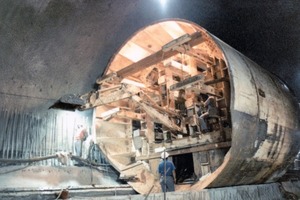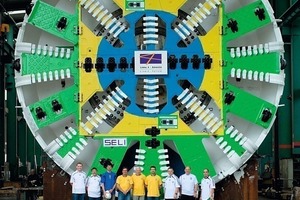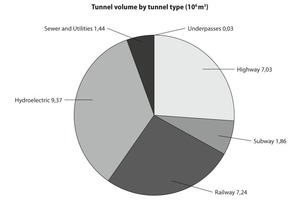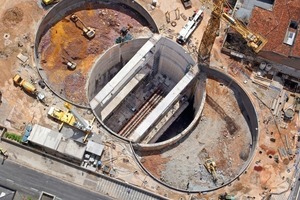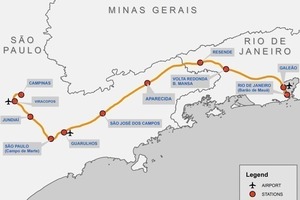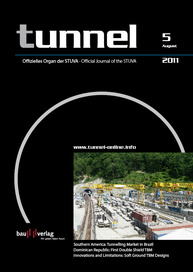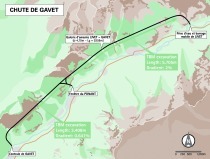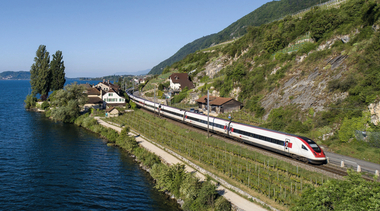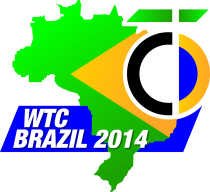Tunnelling Market in Brazil
The following article contains a summary of the history of underground construction in Brazil as well as a summary of present opportunities in the industry when many infrastructure projects are at the planning stage. This happens not only because of the need due to economic growth, but also because of the preparation for the coming FIFA World Championship in 2014 and the Olympic Games in 2016 in Rio de Janeiro. This paper was held at the IUT’11 – Innovation Underground – the famous trade fair in the Hagerbach Test Gallery in Sargans/CH.
The tunnelling market in Brazil started to develop in the second half of the 19th century, even before the advent of dynamite for the excavation of tunnels in rock. At that stage, only 3 centuries after the beginning of the Portuguese colonization, and only a few decades after independence, all the work was planned and conducted by foreign engineers. Very soon the expertise of underground construction and design started to develop among local professionals.
Since those days, of course many changes have occurred in the local tunnelling market. This paper contains a summary of the history of underground construction in the country as well as a summary of present opportunities in the industry when many infrastructure projects are at the planning stage. This happens not only because of the need due to economic growth, but also because of the preparation for the coming FIFA World Championship in 2014 and the Olympic Games in 2016 in Rio de Janeiro.
A thorough and interesting report about the beginning of underground construction in Brazil was compiled by Silva Telles [1]. Excerpts are shown in the following chapters.
The first road and railway tunnels in the country were opened around 1860. But by far the most important engineering work at [<cTracking:-10>] the same period was the long series of 15 tunnels in what was known as Section 2 of the Dom Pedro II Railroad, on the Japeri-Barra do Piraí line across the Serra do Mar mountain range in the state of Rio de Janeiro. Dom Pedro II was then the Brazilian Emperor. He frequently visited [<cTracking:><cTracking:-20>] the construction works. Figure 1 [<cTracking:><cTracking:-10>] is a photograph of the visit on the day of a tunnel breakthrough. That was one of Brazil’s most remarkable engineering achievements at the time: a broad gauge railroad climbed about 400 m in difficult technical conditions requiring the excavation of 15 tunnels, their lengths varying from 25 to 2,238 m and totaling 5,220 m. Some were excavated in soil or decomposed rock, so the vault was lined with masonry, while others were in extremely hard rock. All were 4.2 m wide with a maximum height of 5.8 m. The highlight was the so called Grand Tunnel, 2,238 m in length. [<cTracking:>]
Work on the project as a whole started in 1858, but excavation of the Grand Tunnel was not concluded until June 1864, to be inaugurated in December 1865. The contractor was the American Jacob Humbird. The tunnels in rock (including the Grand Tunnel) were excavated using sledgehammer and chisel with explosives since there were no mechanical drills at that time, and dynamite was not invented until 1866, hence the apparent slowness of the works. The Swiss scientist Jean-Louis Agassiz (who visited the site of the Grand Tunnel in April 1865) reported that the rock was so hard “that the heaviest blows of the diggers produced just a little dust”. In order to facilitate excavation, 4 vertical shafts were sunk from the top of the mountain (depth varying from 37 to 101 m) to allow work to proceed on several faces; one of these shafts was subsequently used for ventilation. About 400 laborers worked day and night shifts.
Underground construction was very active at that time. Work on the so called central line from Rio de Janeiro do Belo Horizonte began in 1865, and there were 20 tunnels, the longest with 552 m. One of those tunnels deserve special attention because it denotes the beginning of engineering concerns with slope stability in that area, a problem which is still important in the same zone nowadays. In the João Ayres Gorge in the Serra da Mantiqueira mountain range, a cut with very high slopes was initially constructed; later on it was converted into a tunnel to avoid railway blockages caused by constant rock falls. For the tunnel (executed in 1901), the vault was built of reinforced concrete, the oldest work with reliable dating to use this material in Brazil.
Between 1877 and 1879, the Maritime branch of the D. Pedro II Railroad in the city of Rio de Janeiro was built. It was a short branch connecting to the port and work included the excavation of 2 tunnels, lengths 315 and 86 m, to cross a hill (Morro de São Diogo). The structure presented 2 important new features: the use of compressed air drills (the Ingersoll system, driven by steam locomotive) and the use of dynamite (the Emperor himself triggered the first blast). The introduction of dynamite brought a significant increase in underground construction. For the duplication of the Dom Pedro II Railway, the new Grand Tunnel was constructed in 11 months, while the first tunnel with the same length had required 7 years.
In the early 20th century Brazilian engineers were in charge of the major works in tunnelling going on in the country. For the access from São Paulo to the Port of Santos, the Mairinque-Santos branch of the former Sorocabana Railroad (São Paulo) was built from 1928 to 1937. The adverse topographical conditions posed difficult technical problems and required the excavation of 31 tunnels (totaling over 5 km) and several viaducts and bridges over a stretch of 40 km. Two of those bridges were world record holders for their respective types of structure at that time.
The execution of almost all the tunnels was supervised by the Brazilian engineer Francisco T. da Silva Telles, who was perhaps Brazil’s leading tunneller at the time.
Modern Tunnelling Market
The development of modern tunnel engineering in Brazil started in the late 1960s with the planning and construction of subway systems in São Paulo and Rio de Janeiro. A few underground hydroelectric schemes had already been constructed. All types of construction methods have been used recently. Line 1 of the São Paulo Metro was partly excavated with an open face TBM (Figure 2) associated with dewatering where necessary. NATM was introduced in the early 1970s for the construction of the Steel Railway between Belo Horizonte and Rio de Janeiro and for the Imigrantes Highway between São Paulo and Santos. Many NATM soft ground tunnels and a few stations were constructed for the São Paulo Subway in the 1980s and 1990s. For the recently constructed Line 4 of the same subway, a modern EPB TBM was used for the excavation of the soft ground section of the double-track running tunnels. The TBM is shown in Figure 3 as an indication of the technological improvements adopted since the 1970s, when compared to Figure 2. About this subject, a hard rock TBM was used for the recently constructed 5 km long Gastau Tunnel to convey natural gas from the sea level to the economic active Vale do Paraíba at 700 m elevation. Advances in drill-and-blast constructin have also been significant.
A recent partial survey carried out by the Brazilian Tunnelling Committee shows that the rate of increase in underground construction for civil engineering purposes is remarkable. The total volume constructed in the 1990s was less than 4 million m3; in the following 5 years the volume jumped to more than 11 million, with a significant pro-rata rate of increase of more than 500 %. The major demand for these new tunnels has come from the hydroelectric construction industry. Since the market rules for private investments for electricity generation have been established a large number of small hydroelectric power plants have been constructed with underground works (Figure 4).
A sample of new works to be constructed in the near future is presented next. Then some of the new projects are described.
New Projects
A number of underground works are in different stages of development in Brazil. This is due to the lasting economic stability, consistent economic growth and high rate of urbanization of the population among other factors. Large metropolitan areas have a backlog of infrastructure which is decreasing.
The table 1 presents some of the projects and their stage of development. This list is by no means exhaustive and represents just a sample of the current activities. As shown later, underground construction for hydroelectric power plants currently represents the largest market share, however it is very difficult to survey mainly after privatization of the sector.
Description of a few Projects
São Paulo Metro Line 5
The southern end of the São Paulo Metro Line 5 is already under construction. The line will be fully underground. The total length will be 11.8 km, out of which 1.5 km will be excavated by NATM; 4.6 km of single-track running tunnels will be excavated by two 6.9 m diameter earth pressure balance TBM; and 5.7 km of double track running tunnels will also be excavated by a 10.6 m diameter TBM. There will be a total of 11 stations, 8 to be constructed with open excavations and 3 by NATM.
In situ geological investigation identified the following horizons:
• Quaternary alluvium sediments (soft and unconsolidated organic clays).
• Tertiary sediments of the Resende and São Paulo Formations (sandy clays and clayey sands; silty clays and silty sands respectively). Most of the experience in tunnel excavation in the City of São Paulo has been accumulated in these formations.
• Weathering soil (Gneiss saprolite).
• Moderately weathered granitic gneiss.
An important characteristic of this line is the intense use of TBMs for running tunnels and open excavations for stations. Several stations will be excavated using multi-shafts with shotcrete support, such as Luz Station of Line 2, shown in Figure 5. For the Adolfo Pinheiro Station, already under construction, a total of 5 secant shafts with 30 m diameter are being excavated.
São Paulo Metro Line 6
São Paulo Metro Line 6 is at the preliminary design stage. It will connect the Brasilândia (north
western part of the city) to São Joaquim (downtown area) stations with a total extension of 15.3 km. Running tunnels will be mainly excavated with TBM through several geological formations. The anticipated demand for this line is 638,000 passengers per day. Most of the length will be excavated with a 9.4 m diameter TBM for double-track tunnels through tertiary sediments and a short section through weathered gneiss. A short length of double-track tunnels will be excavated with a TBM through rocks ranging from class I to class III. Conventional excavation methods will be adopted in a short section of granitic rock.
Fortaleza Metro Line 3 – East
Fortaleza is the capital city of the state of Ceará in northeastern Brazil. Line 3, currently under preliminary design, will connect the downtown area to the south eastern part of the city. The terminal station will be located next to the Campus of the University of Fortaleza.
The running tunnels will be excavated with TBM for single track through sediments of the Barreiras Formation. All the 12 stations will be constructed with open excavation. This is favored by the local physiographical condition. An important aspect is the need to pressurize the TBM in order to minimize surface impacts due to the thick sand layers occurring in the region.
Rio de Janeiro Metro
Line 4 of the Rio de Janeiro Metro was planned in the late 1990s when the system was transformed into a concession. The original project aimed at connecting Barra da Tijuca, at the extreme south of the city, to the Botafogo Station, which was at that time Line 1 southern terminal station. Line 1 links the northern and southern zones of the city through downtown.
Since the late 1990s, Line 1 was successively extended towards south through Copacabana, reaching Ipanema at the General Osório Station. New studies showed importance of connecting Barra da Tijuca to Ipanema, changing the original alignment of Line 1. Many important real estate development projects have taken place in Barra da Tijuca in recent years. Highly congested avenues are presently the only possible connection to the downtown area and trips can take as much as 2 h for the 28 km. In addition, may sport facilities will be constructed in the Barra da Tijuca area for the 2016 Olympic Games and Ipanema and Copacabana are the zones where most of the hotels are located.
The new alignment of Line 4 will connect General Osório Station in Ipanema to Jardim Oceânico Station in Barra da Tijuca. The fully underground line will be 14 km long with 6 new stations. It will be possible to reach downtown in 34 min and Copacabana in just 15 min.
Running tunnels between General Osório and Gávea Stations through the densely constructed Ipanema and Leblon districts will be excavated with TBM. Between Gávea and Jardim Oceânico the construction method will be drill and blast. The new General Osório Station will be fully constructed underground by the drill and blast method, taking profit of the good quality rock mass. Experience of successfully constructed nearby stations (e.g. Cardeal Arcoverde) with shotcrete for final lining will be taken into consideration, according to the practice frequently adopted in Brazil [3].
Gavea Station will be excavated by the cut-and-cover method, using the multi-shaft technique, similar to the one shown in Figure 5. This technique has proven to be very safe, cost-effective and logistically efficient during construction. It has become very popular in Brazil and has been adopted for many mass transit stations. A total of 7 secant shafts are planned to be excavated to accommodate platforms, concourse, accesses, operational and technical rooms. Gavea will be an important station at the entrance of the Catholic University Campus.
The project is at early construction stage. The drill-and-blast tunnel between Jardim Oceânico and Gávea is being excavated. Specifications for the TBM which will be used to excavate the running tunnels between General Osório and Gávea Stations are currently being prepared. Excavation for the General Osório Station has already started.
Line 3 is still at planning stage. It will connect Rio de Janeiro to Niterói on the west side of the Guanabara Bay through a trans-bay tunnel. From Niterói the line is planned to extend about 30 km west to Itaboraí.
High Speed Rail System
A high speed rail system (HSR) is being planned to operate in the most populated and economic active region in the country. The National Agency for Land Transportation (ANTT) has been commissioned by the Federal Government to conduct the TAV Brasil project (www.tavbrasil.gov.br). The Consortium Halcrow – Sinergia was commissioned to conduct the feasibility studies. Excerpts of the feasibility study are presented below [4].
Existing transport modes air, car and bus are well established in the market between the 3 cities, in particular the high frequency air shuttle connecting the cities of Rio de Janeiro and São Paulo. In 2008, the total estimated demand between Rio de Janeiro and São Paulo was 7.3 million trips with a market share for air of 60 %, 17 % for car and 23 % for bus. For the whole system, studies indicated a demand of 18.0 million trips in 2008 and 32.6 million in 2014. The air shuttle, which has a 15 min frequency, a 55 min gate-to-gate travel time and currently 71 daily flights in each direction, dominates the market for time sensitive business passengers. The system however is sensitive to weather conditions and significant delays occur. In addition, Congonhas airport in São Paulo located close to the central business district is saturated. The need for a high speed rail system is clear.
The HSR will run between Campinas, São Paulo and Rio de Janeiro (Figure 6) also connecting the airports of Viracopos, Guarulhos and Galeão to their metropolitan areas. The system is intended to operate at a maximum speed of 350 km/h The total estimated distance between Campinas and Rio de Janeiro is 511 km; with the distance between São Paulo and Rio de Janeiro approx. 412 km. Based on the alignment developed the non-stop journey time between the 2 cities is estimated at approx. 1 h 33 min. Journey times with a high speed long distance service between Rio de Janeiro to Campinas will take up to approx. 2.5 h.
The alignment proposed by ANTT will have 90.9 km of tunnels, 46.6 of which will be located in urban areas and 44.3 in rural areas. In rural areas, the longest tunnels will be located at the Serra das Araras, an escarpment with about 500 m difference in elevation composed of gneissic rock. The total construction cost estimated by ANTT for the tunnels will be US$ 6.3 billion at the stage of feasibility studies. For bridges and viaduct the estimate reaches US$ 4.2 billion. The total estimate for civil works is US$ 14.5 billion. Those costs will be reviewed when a preliminary engineering design becomes available. The bidding process for the concession (design, build and operate) is currently underway.
The design of this urban tunnel is an example of an important market share for underground works in Brazil in the coming years. In this case, underground traffic solutions are being considered to upgrade the area above. The project is coupled with the real estate market and part of the construction cost will be covered by the profit due to the urban rehabilitation. Potential use of this type of coupled solution is very high in many Brazilian cities.
The City of São Paulo created a program for urban rehabilitation of the area around the Água Espraiada Creek in the southern part of the city, between Imigrantes Highway (the most important highway to the city and port of Santos) and the Pinheiros River Marginal Avenue, an area which has become an important business district in recent years. An urban operation was created by the City with the purpose of generating funds for the project of construction of an avenue along the creek. The first section of the avenue has already been constructed, the so called Roberto Marinho Avenue. The final 3 km before reaching Imigrantes Highway are irregularly occupied by low income housing. About 7,000 families living there will be moved to new apartments to be built by a social interest housing program. The original project called for the construction of the remaining 3 km at-grade avenue. Urbanistic studies however, showed that an underground solution, preserving the surface for a linear park with approx. 3 million m2 would have much further positive impact on the neighborhood.
Two twin tunnels for 3 lanes each, 147 m2 cross section area and 15.7 m span are at the final design stage. Lay-bys for emergency parking will have 168 m2. The tunnels will be excavated in soft ground, mainly consisting of stiff clay and sand layers from the São Paulo Tertiary Basin and limited length in residual soil resulting from the weathering of Pre-Cambrian gneiss. The need for blasting hard rock for bench excavation only will be rare. The excavation scheme will include side drifts, top-heading and bench. The primary support will consist or fiber-reinforced shotcrete. For the final lining, steel mesh reinforced shotcrete will be adopted.
Conclusions
The tunnelling market in Brazil is at clear increase rate of demand. Backlog of infrastructure due to recent and continuing growth, as well as on-going urbanization process tends to decrease, but many works are expected to be contracted in coming years. In addition to the backlog, demand due to important sport events in the coming years is also expected to increase.

![Visit of the Emperor to the Grand Tunnel breakthrough [1]](https://www.tunnel-online.info/imgs/tok_b6c3905262e20d08bfdbf4cd49ab18ea/w300_h200_x400_y560_100837918_7335a1e50e.jpg)
